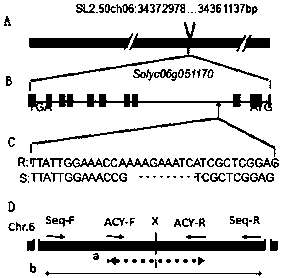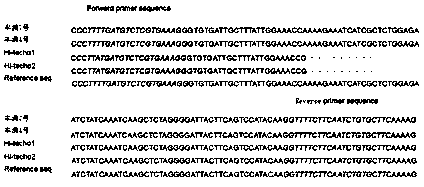Primer ACY of Ty-3 molecular marker and indexing method thereof
A molecular marker and marker primer technology, applied in the field of bioengineering, can solve the problems of false positives, time-consuming genotyping, and high cost, and achieve the effects of simple operation, guaranteed labeling results, and time and cost savings.
- Summary
- Abstract
- Description
- Claims
- Application Information
AI Technical Summary
Problems solved by technology
Method used
Image
Examples
Embodiment 1
[0023] In this example, according to the genome sequences of wild tomato (Solanum pennellii) and cultivated tomato (Solanum lycopersicum), the sequences of the Ty-3 candidate gene Solyc06g051170 were compared in the NCBI database using the BLAST tool, and it was found that there were single bases and 2 bases , 3 bases, 4 bases, or even 9 bases, 10 bases. According to the deletion of 9 bases and 10 bases, use the designed primers to carry out PCR amplification with 6 disease-resistant commercial varieties and 6 susceptible commercial varieties. It is found that the primers designed according to the 10bp deletion can well distinguish the resistant Susceptible varieties, and the band pattern is obvious and clear, the band size of the amplified resistant variety is 132bp, and the fragment size of the susceptible variety is 123bp. It is predicted that the InDel marker is located on tomato chromosome 6, the position of the fourth intron of the Ty-3 candidate gene solyc06g051170 frag...
PUM
 Login to View More
Login to View More Abstract
Description
Claims
Application Information
 Login to View More
Login to View More - Generate Ideas
- Intellectual Property
- Life Sciences
- Materials
- Tech Scout
- Unparalleled Data Quality
- Higher Quality Content
- 60% Fewer Hallucinations
Browse by: Latest US Patents, China's latest patents, Technical Efficacy Thesaurus, Application Domain, Technology Topic, Popular Technical Reports.
© 2025 PatSnap. All rights reserved.Legal|Privacy policy|Modern Slavery Act Transparency Statement|Sitemap|About US| Contact US: help@patsnap.com



